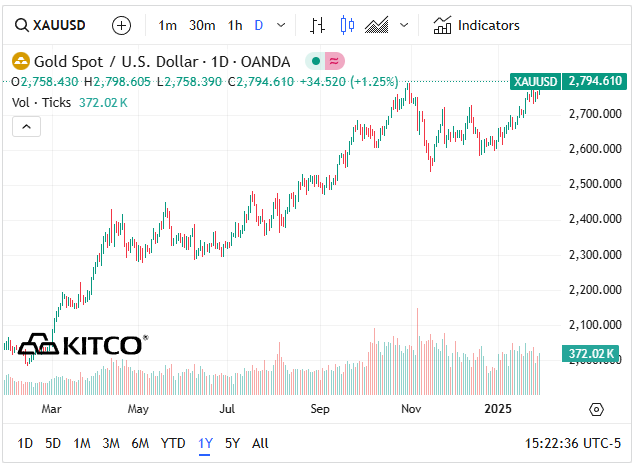Juniors and the Price of Gold
Goldbugs are on the edge of their seats wondering if gold will break through $2800 US an ounce. Like all round numbers, $2800 is a psychologically important moment and it may shift the general market’s interest towards junior resource companies. Or it may not. What is certain is that the rise in the price of gold has changed a lot of the value modelling which makes up the 43-101 Mineral Resource Estimates, the Preliminary Economic Assessments and Pre-Feasibility Studies. This is where the actual impact will be felt in the junior resource market.
How do you value a potential mineral deposit? Whether it is gold, silver, copper or tin the basic question is the same, only the precision of the answer changes as more work is done: how much economic rock is there? The price of the mineral targeted determines the answer. In toy model terms, rock grading 1 gram of gold per ton may not be economic if the price of gold is $1200 a ton, but at $2800 that rock may be very economic indeed.
When a company does a Preliminary Economic Assessment its consultants have to use a number for the price of whatever mineral it is going after. For example, Cartier Resources (ECR.V) put out a PEA in 2023 which was based on a MRE completed in 2022. That PEA gave an Internal Rate of Return of 20.8%. Critically it was based on:
Long term gold price of US$1,750/oz, Exchange rate of CAD $1.00 = US$0.77
When the PEA came out ECR was trading between $0.12 and $0.15. It is now trading around $0.10.
Adding $1000/oz to the gold price and taking the CAD $1.00 = US$0.69 will, rather obviously, dramatically improve Cartier’s modelled Internal Rate of Return. In the press release announcing its PEA Cartier helpfully included a Gold Price sensitivity table:
Yes, it does only go to $2200 gold. Eye balling these numbers, a $100 increase in the gold price looks to be worth an increase of a bit over 2% Post Tax IRR.
But gold price has another effect: it brings more gold into play. When doing an MRE the consultants use a “cut-off grade” to exclude uneconomic rock from the indicated and inferred tonnage. That cut-off grade is a function of the price of gold at the time the MRE is written. In ECR’s case, cut-off grades of 1.5 gpt and 2.0 gpt were used to exclude rock based on a gold price of $1612/oz. That gave Cartier 720,000 indicated gold ounces and 1,633,000 ounces inferred. Using $2700 would add a significant number of ounces.
Now Cartier has been drilling up a storm and plans on a huge drilling program in 2025 but the fact is that it might well be able to report a revised MRE and PEA simply by running the calculations with the new gold price and the discounted dollar.
Much the same revision can be made for most gold explorers. Here’s Tara Christie’s Banyan Gold (BYN.V) in the Yukon:
Mineral Resources are reported at a cut-off grade of 0.30 g/t gold for all deposits, using a US$/CAN$ exchange rate of 0.75 and constrained within an open pit shell optimized with the Lerchs-Grossman algorithm to constrain the Mineral Resources with the following estimated parameters: gold price of US$1,800/ounce…
Bumping the gold price up to, say, $2500 makes the already expanding Banyan project even more attractive.
Pure gold explorers will benefit from the gold price rise, but so will companies like Canadian Critical Minerals (CCMI.V) who are shipping other material - in this case copper - with gold credits. 424 tons shipped in December had 339 grams of gold credits which at a current gold price of $130.20 per gram meant a payout of $44,000. (All USD).
It is prudent for any junior resource company and its consultants to be conservative in their modelling. After all, Mr. Stompy gets into the office at about 9 Eastern time and unloads supply (usually paper) into the market and the price of gold goes down. While he seemed to forget on the 30th, no junior resource CEO counts much on the day-to-day gold price. After all, most of the exploration companies are years away from actually mining the resource they are defining.
Gold hitting all-time highs will mean investors and analysts will rethink and reimagine exploration projects with, perhaps, more optimistic assumptions. Potential acquirers, usually gold producers themselves and rolling in cash from the price rise, will think seriously about how they can replenish their reserves. Junior resource company investors may see the beaten up values of their portfolios begin to rise.
It is very much worth an investors time to look at the gold price assumptions built into junior resource company’s models. There can be a lot of room for an “upside surprise”.
(Disclaimer: I hold positions in Cartier Resources, Banyan Gold and Canadian Critical Minerals which I may buy or sell at anytime. This is not investment advice. Do your own due diligence. Call the CEO)




